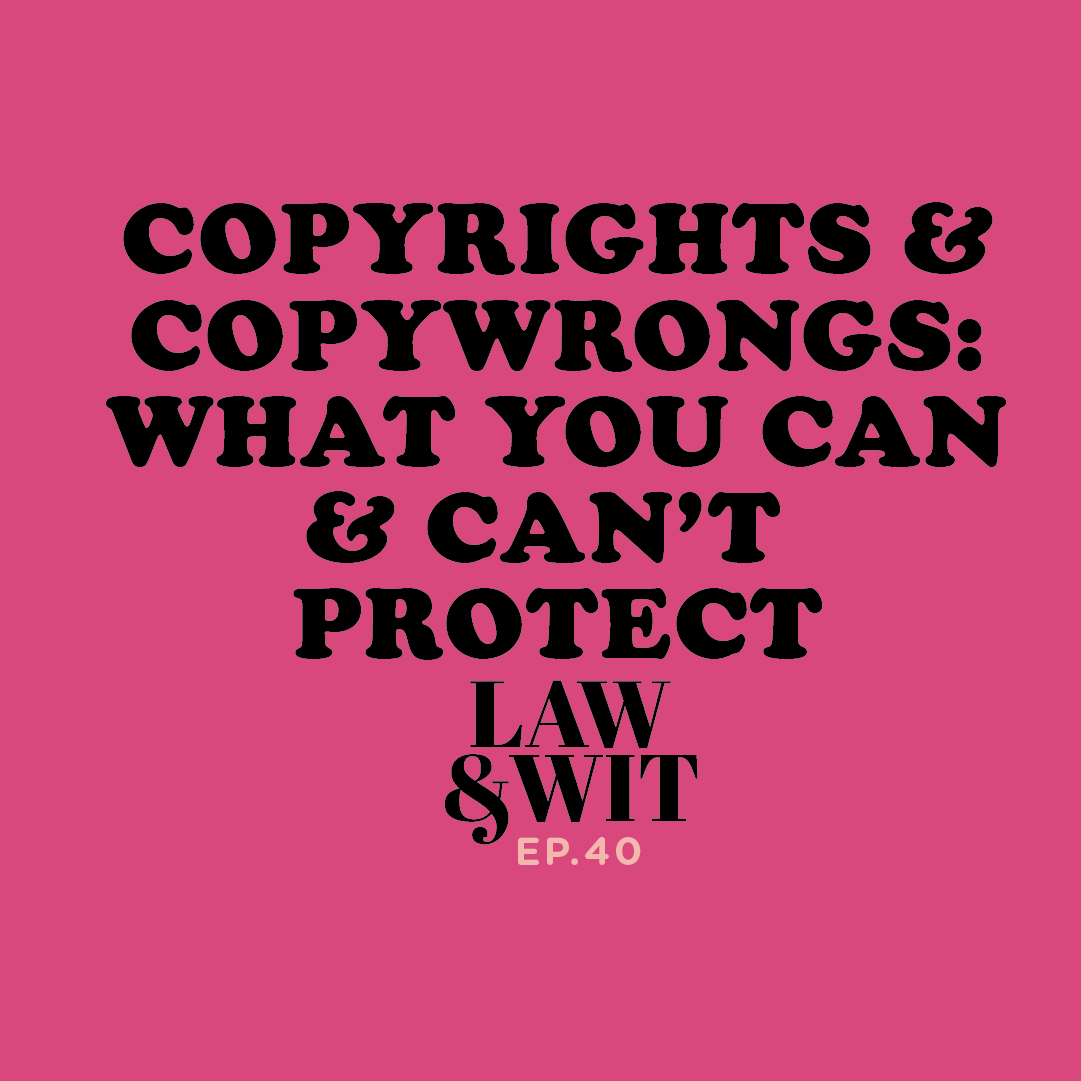What can I copyright?
This is the fourth and final episode of the Business Legal Systems series that discusses the things you need to know in getting your creative business up and running right from the get-go. If you want to make sure that all the hard work you’ve invested into your business is protected, this is the episode for you.
Part 1- Where Do I Start? discussed how to properly setup your business. Part 2 – How to Get Your Site Legit covered how to make sure your website has everything in it that you need. And, Part 3: Get It In Writing: Contracts 101 discussed the importance of contracts in your business. In Part 4, host Brittany Ratelle, attorney for creative entrepreneurs will discuss what you need to know about protecting your work through Copyright.
In this episode, you will learn
-
What the four main tools for protecting your work
-
What things you can copyright
-
What things you can’t copyright
-
Why it’s actually a good thing that you can’t copyright everything you wished you could
-
How to know if you have a copyright
-
The benefits of registering your copyright even though you already have some protection
-
Where to find more information on Trademarks and Patents
-
A friendly reminder about what’s good for YOUR soul about where your value and worth are as a creative entrepreneur
Episode Links
Business Legal System Part 1 – Where Do I Start?
Business Legal System Part 2 – Part 2 – How to Get Your Site Legit
Business Legal System Part 3 – Part 3: Get It In Writing: Contracts 101
Law & Wit Episode 11: What to do When People Copy Your Stuff
Law & Wit Episode 24: 6 Ways a Trademark can Protect Your Brand
QUOTES
“You can’t protect your recipe because it’s just a list of ingredients. It’s too functional. There are only so many ways to put stuff together to make a chocolate chip cookie. But, what you can protect is the photos of your photography, if you took them then they’re yours. An original illustration that came with it. So if you have some fancy calligraphy or hand-lettering that went with it that’s really cool, you can protect that. You could protect the narrative…the text in your Instagram post, your YouTube video about it. that expression of stuff you can definitely protect, so not all is lost, but just not the actual recipe. But that’s OK, because it’s not just about the recipe, it’s about the stuff that goes with it. No one can do it like you.”
“You are still a creator or a creative and just because you can’t protect the expression of something that you do, doesn’t mean that other people can do it like you.”
“We’re not all Einsteins here creating things from scratch, and that’s OK.”
“And, when you figure that out and hone in and dig deep on what is your brand about, what is your story about, and what are you sharing with other people, then you’re going to find that those things are very difficult for someone else to replicate in exactly the way that you do them.”
Four Main Tools for Protection
1. Copyright – This is something that is original and creative. It’s not protected when it’s in your brain, but when you get your idea out of your brain it becomes protected. For example, if you scribble song lyrics down on a napkin and snap a picture of it, it can be protected through copyright.
2. Trademark – This answers the questions “who made this?’ or “who sells this?”. The real benefit of a trademark goes to the consumer. If someone reaches for a Coke they know what they are going to get. The name, logo, and even the way the bottle is shaped can be trademarked. This keeps confusion out of the marketplace.
3. Patent – Things that are patented need to be new, not obvious, and useful. If you think you have an idea that is worth patenting it makes sense to have a free consult with an attorney that works with patents. The cost can be expensive and time-consuming but could be worth it based on your situation.
4. Trade Secrets – These are things that are protected through contract. For example, if you make cupcakes and have a special recipe you aren’t going to want that recipe shared everywhere. When you hire employees you can have them sign a Non-disclosure Agreement (NDA) stating that they will not share inside information such as the recipe. This can apply to other areas like vendor lists, research you have gathered, and your business model.
Remember that the world misses 100% of the work that you don’t create. So, as a creative entrepreneur, don’t let fear of having your work ripped off stop you from creating.
HELPFUL RESOURCES
Make sure you’re legally legit with my free legal workbook!
Do you have the contracts you need in place? Take a free quiz and find out exactly what you need for your business at creativecontracts.co.
Listen and subscribe to Creative Counsel on iTunes, Overcast, Stitcher, Spotify, and iHeartRadio.
Or browse through my quick tips and tricks by connecting on Instagram.
LET’S CONNECT
Interested in working together for one-on-one legal services? Book some time on my calendar!
*This blog post is not intended as legal advice. No attorney-client relationship. For informational purposes only.

[…] this is counterintuitive to what an attorney would cover. After all, I recently did a podcast on protecting your brand, copyrights, trademarks, and overall how to protect your […]
[…] Copyrights and Copywrongs, what you can and can’t protect – Episode 40 […]